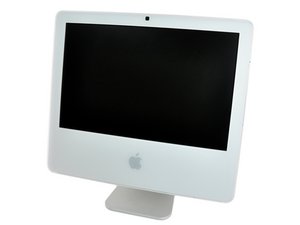This hard drive SHOULD be compatible with your iMac assuming you do have a 17" Intel iMac. The early Intel iMacs used the SATA I specification of 1.5Gbit/s. This hard drive shows as using the SATA II specification, which is backwards compatible with the SATA I specification.
With that in mind I would be troubleshooting the component itself. Was the hard drive simply an upgrade or is it to replace a failed/failing hard drive? It's possible that the new hard drive is defective. It would be odd to see that but it is certainly possible.
I would try the following:
- Reinstall the original hard drive and verify that it shows up in Disk Utility - this will let you know that the SATA cables and connections on the logic board are functioning.
- Connect the new hard drive to another computer (if available, either by installing or using a SATA to USB/FW adapter) - this will let you know if the new drive is functioning
- Reinstall the new hard drive and try again
- With the new hard drive still installed, attempt an SMC reset as well as a PRAM/NVRAM reset
SMC RESET
• Shut down the computer.
• Unplug the computer's power cord and all peripherals.
• Press and hold the power button for 5 seconds.
• Release the power button.
• Attach the computers power cable.
• Press the power button to turn on the computer.
PRAM / NVRAM RESET
• Shut down the computer.
• Locate the following keys on the keyboard: Command, Option, P, and R. You will need to hold these keys down simultaneously in step 4.
• Turn on the computer.
• Press and hold the Command-Option-P-R keys. You must press this key combination before the gray screen appears.
• Hold the keys down until the computer restarts and you hear the startup sound for the third time.
• Release the keys.
Hopefully this either resolves the issue or identifies where the fault is. Good luck!
Bu yanıt yardımcı oldu mu?
Oy verildi
Geri al
Puan
0
İptal
Bu yoruma uygun yeri bulmak için bu konuyu kaydırın. Ardından, taşımak için "Bu yazıya yorum ekle"ye tıklayın.

 2
2  1
1 
 2,6b
2,6b 

2 Yorum
In case this information helps, our old hard drive is a Western Digital WD1600JS. The new hard drive is a Seagate Barracuda Green ST1000DL002.
We didn't have any problems following the installation instructions, and just to double check that everything was connected properly, we just went in and re-did the whole install of the new drive being careful to check the connections.
When we hold down the option key and boot from the Snow Leopard Install DVD, and then select Disk Utility from the Utilities menu, no hard drive disk shows up. When we click on System Profiler we don't see the new hard drive information there either.
Any ideas what the problem could be?
Melissa Yatzeck tarafından
http://knowledge.seagate.com/articles/en...
rossy65 tarafından